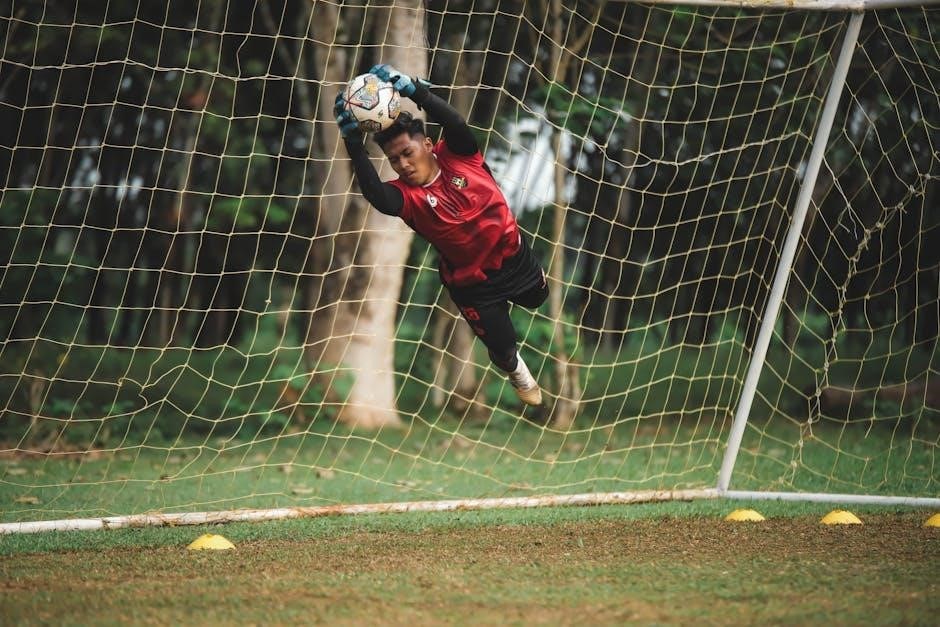Following post-operative instructions after dental implant surgery is crucial for proper healing and minimizing complications. Downloadable PDF guides provide detailed care steps‚ ensuring a smooth recovery process.
1.1 Importance of Following Post-Op Instructions
Adhering to post-operative instructions is vital for ensuring proper healing and minimizing complications after dental implant surgery. These guidelines help prevent infection‚ promote bone integration‚ and reduce discomfort. By following the recommended care steps‚ patients can avoid issues like implant failure or prolonged recovery. Proper wound care‚ dietary restrictions‚ and medication use are critical during the initial healing phase. Ignoring these instructions may lead to setbacks‚ making compliance essential for achieving optimal results and a successful implant outcome.
1.2 Overview of the Healing Process
The healing process after dental implant surgery typically lasts several months. Immediate post-surgery care focuses on managing swelling and bleeding‚ while the initial 1-2 weeks involve soft tissue healing. Osseointegration‚ where the implant fuses with the bone‚ occurs over 3-6 months. Following post-operative instructions ensures proper recovery‚ minimizing complications and promoting successful implant integration. Detailed guides‚ often provided in PDF format‚ outline timelines and care steps to support patients throughout the healing journey.

Immediate Post-Surgery Care
Managing bleeding‚ swelling‚ and discomfort is critical immediately after implant surgery. Gauze placement‚ rest‚ and avoiding hot foods/drinks help promote healing and reduce post-operative discomfort.
2.1 Managing Bleeding and Swelling
Bleeding and swelling are common after implant surgery. To control bleeding‚ bite firmly on gauze for 30-60 minutes. Elevate your head while resting to reduce swelling. Apply ice packs to the affected area for 15-20 minutes every hour during the first day. Avoid strenuous activities that could dislodge the blood clot. Minor oozing is normal‚ but if bleeding persists‚ contact your surgeon immediately for further guidance.
2.2 Gauze Placement and Pressure
Place gauze over the surgical site and apply firm‚ steady pressure to control bleeding. Keep the gauze in place for 30-60 minutes or as directed. If bleeding continues‚ replace the gauze with a clean‚ moistened one. Avoid disturbing the site or dislodging the blood clot‚ as this is crucial for healing. If bleeding persists despite these measures‚ contact your surgeon for further instructions to ensure proper recovery and prevent complications.
2.3 Rest and Activity Level
Rest is essential immediately after implant surgery to promote healing. Avoid strenuous activities‚ bending‚ or heavy lifting for 24-48 hours. Keep your head elevated while sleeping to reduce swelling. Engage in light activities only‚ such as reading or watching TV‚ to minimize stress on the surgical site. Avoid exercise or physical exertion for 3-5 days‚ as this can dislodge the blood clot and delay recovery. Proper rest supports optimal healing and ensures the best outcomes for your implant procedure.

Pain Management
Manage pain with prescribed medications or over-the-counter options as directed; Monitor symptoms and contact your surgeon if pain worsens or persists beyond expected levels.
3.1 Prescribed Medications
Prescribed medications are essential for managing pain and inflammation after implant surgery. Follow the dosage instructions carefully to avoid complications. Narcotics or antibiotics may be prescribed to ensure proper healing. Start medications as directed‚ typically after the local anesthetic wears off. Monitor side effects and adjust as needed. If pain persists despite medication‚ contact your surgeon immediately. Always adhere to the prescribed regimen to support recovery and prevent infection.
3.2 Over-the-Counter Pain Relief
Over-the-counter pain relievers‚ such as ibuprofen or acetaminophen‚ can effectively manage mild to moderate discomfort after implant surgery. These medications reduce inflammation and alleviate pain. Start with the recommended dosage as instructed on the label or by your surgeon. Avoid overuse to prevent side effects. If pain persists despite OTC medication‚ contact your surgeon for stronger prescription options. Always monitor for any adverse reactions and adjust usage accordingly to ensure safe and effective pain management during recovery.
3.4 When to Contact Your Surgeon
Contact your surgeon immediately if you experience excessive bleeding‚ severe pain‚ or signs of infection such as fever‚ redness‚ or pus. If swelling increases after 3-4 days or numbness persists‚ seek medical attention. Notify your surgeon if medications are ineffective or if the implant feels loose. Any unusual symptoms‚ such as implant exposure or persistent discomfort‚ require prompt evaluation to prevent complications and ensure proper healing.

Diet and Nutrition
A soft‚ nutrient-rich diet is essential after implant surgery. Stick to foods like yogurt‚ smoothies‚ and mashed vegetables‚ avoiding hard or sticky items that could disrupt healing.
4.1 Recommended Soft Foods
After implant surgery‚ opt for soft‚ easy-to-chew foods to promote healing and avoid discomfort. Recommended options include yogurt‚ smoothies‚ mashed vegetables‚ and soft-cooked pasta. Avoid hot foods initially‚ as they may irritate the surgical site. Choose mild flavors and textures to minimize irritation. Soft foods help prevent dislodging the implant or causing unnecessary strain during the recovery period.
- Yogurt and soft cheeses
- Smoothies and pureed fruits
- Mashed potatoes and soft vegetables
- Soft-cooked pasta and scrambled eggs
4.2 Avoiding Certain Foods
To ensure proper healing‚ avoid foods that may irritate the surgical site or interfere with the implant. Hard‚ crunchy‚ or sticky foods can dislodge the implant or cause discomfort. Spicy or acidic foods may also irritate the gums. Avoid chewing on ice‚ nuts‚ or hard candies. Additionally‚ refrain from consuming foods like chips‚ raw vegetables‚ or caramel apples during the initial healing phase. Stick to soft‚ gentle foods for the first few weeks to promote recovery and protect your implant.
- Hard or crunchy foods (e.g.‚ nuts‚ chips)
- Sticky foods (e.g.‚ caramel‚ toffee)
- Spicy or acidic foods
- Raw vegetables or hard fruits
4.3 Staying Hydrated
Staying hydrated is essential for proper healing after implant surgery. Drinking plenty of water helps maintain oral hydration and supports the recovery process. Avoid hot liquids for the first 24 hours‚ as they can cause discomfort or bleeding. Opt for cool or room-temperature water and soft‚ non-acidic drinks. Proper hydration also prevents dry mouth‚ which can irritate the surgical site. Aim to drink at least 8-10 glasses of water daily to ensure optimal healing and comfort during your recovery period.

Oral Hygiene
5.1 Brushing Teeth Gently
Begin brushing your teeth gently the day of surgery using a soft-bristle toothbrush. Avoid the surgical site but clean surrounding areas to maintain oral hygiene. Use mild toothpaste and focus on areas not near the implant. Gently rinse with warm water or antiseptic mouthwash as directed. Avoid vigorous brushing‚ which could dislodge the implant or cause bleeding. This careful approach ensures proper healing and prevents complications while keeping your mouth clean and comfortable during recovery.
Begin brushing your teeth gently the day of surgery using a soft-bristle toothbrush. Avoid the surgical site but clean surrounding areas to maintain oral hygiene. Use mild toothpaste and focus on areas not near the implant. Gently rinse with warm water or antiseptic mouthwash as directed.
Avoid vigorous brushing‚ which could dislodge the implant or cause bleeding. This careful approach ensures proper healing and prevents complications while keeping your mouth clean and comfortable during recovery.
5.2 Salt Water Rinses
Start salt water rinses the day after surgery to promote healing and reduce swelling. Dissolve 1/2 teaspoon of salt in 1 cup of warm water. Swish gently around your mouth‚ focusing on the surgical site‚ for 30 seconds before spitting out. Repeat this 2-3 times daily‚ especially after meals‚ for the first two weeks.
Salt water rinses help kill bacteria‚ soothe discomfort‚ and keep the area clean. Be gentle to avoid dislodging the blood clot or irritating the implant site.
5.3 Use of Antiseptic Mouthwash
Using an antiseptic mouthwash‚ such as Peridex‚ can help reduce bacteria and inflammation around the implant site. Start using it 24 hours after surgery‚ as directed by your surgeon. Swish the solution gently in your mouth for 30 seconds‚ focusing on the surgical area‚ before spitting it out. Use it 2-3 times daily‚ especially after meals‚ to maintain cleanliness and promote healing.
Avoid overusing antiseptic mouthwash‚ as it may irritate the gums. Always follow the instructions provided by your dental professional for optimal results.

Common Post-Operative Issues
Common issues after implant surgery include swelling‚ bruising‚ numbness‚ or tingling. Monitor for signs of infection‚ such as fever or pus‚ and contact your surgeon if concerns arise.
6.1 Swelling and Bruising
Swelling and bruising are common after implant surgery‚ typically peaking within 24-48 hours. Applying ice packs to the affected area can reduce swelling. Elevating the head while resting also helps minimize swelling. Bruising may appear as discoloration and can take several days to resolve. Gentle care and avoiding strenuous activities during the initial healing phase are recommended to prevent worsening of these symptoms.
6.2 Numbness or Tingling
Numbness or tingling near the implant site can occur due to nerve irritation during surgery. This is usually temporary and resolves as healing progresses. However‚ if these sensations persist or worsen‚ contact your surgeon promptly. Avoid chewing directly on the implant until full sensation returns to ensure proper healing and prevent further irritation. Monitoring these symptoms is crucial for optimal recovery and implant success.
6.4 Signs of Infection
Signs of infection after dental implant surgery may include fever‚ redness‚ swelling‚ or pus around the implant site. If you notice excessive pain‚ bleeding‚ or a foul odor‚ contact your surgeon immediately. Infection can delay healing and compromise the implant’s success. Early intervention is critical to prevent complications. Monitor your symptoms closely and follow post-operative care instructions to minimize the risk of infection and ensure proper healing.
Medications
Medications prescribed after implant surgery may include antibiotics to prevent infection‚ painkillers for discomfort‚ and anti-inflammatory drugs to reduce swelling. Follow dosage instructions carefully.
7.1 Antibiotics
Antibiotics are prescribed to prevent infection after implant surgery. They help combat bacterial growth around the implant site‚ ensuring proper healing. It’s essential to complete the full course as directed‚ even if symptoms improve. Missing doses or stopping early can lead to incomplete healing or infection. Always follow the dosage instructions provided by your surgeon to maintain effectiveness and minimize potential side effects. Adherence ensures the best outcomes for implant integration and overall recovery.
7.2 Painkillers
Painkillers are prescribed to manage discomfort and swelling after implant surgery. Start taking them as directed upon arriving home‚ preferably with food to avoid stomach upset. Over-the-counter options like ibuprofen or acetaminophen can also be used if approved by your surgeon. Avoid exceeding the recommended dosage to prevent side effects. If pain persists or worsens despite medication‚ contact your surgeon for further guidance. Proper use of painkillers ensures a more comfortable recovery and supports the healing process effectively.
7.3 Anti-Inflammatory Drugs
Anti-inflammatory drugs are often prescribed to reduce swelling and inflammation after implant surgery. They play a crucial role in minimizing discomfort and promoting a smoother recovery. These medications are typically used alongside painkillers and should be taken as directed by your surgeon. Always follow the recommended dosage to avoid side effects. Anti-inflammatory drugs help prevent complications and support the healing process. If symptoms persist despite medication‚ consult your surgeon for further evaluation and adjustments to your treatment plan.

Activity Restrictions
Avoid strenuous exercise‚ heavy lifting‚ and bending for 48-72 hours post-surgery. Rest is crucial for healing. Limit physical activity to prevent dislodging the implant or causing complications.
8.1 Avoiding Strenuous Exercise
Avoid strenuous exercise‚ heavy lifting‚ or bending for 48-72 hours post-surgery. Rest is essential to allow the implant to heal without disruption. Activities like running or weightlifting can dislodge the implant or cause complications. Light walking is usually permissible but consult your surgeon for specific guidance. Excessive movement can interfere with the healing process‚ so prioritize rest to ensure proper osseointegration and a smooth recovery. Avoid any activity that raises heart rate or blood pressure excessively during this period.
8.2 Smoking and Healing
Smoking significantly impairs healing after implant surgery by reducing blood flow and delaying tissue repair. Nicotine constricts blood vessels‚ limiting oxygen and nutrient delivery to the surgical site. This increases the risk of implant failure and prolongs recovery. Patients are strongly advised to avoid smoking for at least 48-72 hours post-procedure and ideally until fully healed. Smoking can lead to complications such as dry socket or infection‚ undermining the success of the implant. Consider a temporary cessation to support optimal healing outcomes and ensure long-term implant stability.
8.3 Alcohol Consumption
Avoid alcohol consumption for at least 48-72 hours after implant surgery‚ as it can increase bleeding risk and interfere with healing. Alcohol thins the blood‚ delaying clot formation and prolonging recovery. It may also interact with prescribed medications‚ reducing their effectiveness. Additionally‚ alcohol can irritate the surgical site‚ leading to discomfort and potential complications. Abstaining during the initial healing phase supports better recovery outcomes and ensures the implant integrates successfully with the surrounding tissue.

Follow-Up Appointments
Regular follow-up appointments are essential to monitor healing progress‚ remove sutures‚ and ensure proper implant integration. These visits help prevent complications and confirm successful recovery.
9.1 Suture Removal
Suture removal typically occurs 7-10 days after surgery‚ depending on healing progress. Dissolvable sutures may not require removal‚ while traditional sutures are gently taken out by your dentist. This procedure is quick and ensures proper healing. Attend your scheduled appointment to have sutures removed‚ as retained sutures can cause irritation or infection. Your dentist will also assess the implant site during this visit to confirm everything is healing as expected.
9.2 Implant Uncovering
Implant uncovering is a minor procedure to expose the implant head after the healing period. This step is necessary for attaching the abutment and crown. If the implant was buried under the gum‚ your dentist will make a small incision to reveal it. The procedure is typically quick and may require local anesthesia. Once uncovered‚ the implant is ready for the next stage of restoration‚ ensuring proper function and aesthetics of your new tooth. This step is crucial for completing the implant process successfully.
9.4 Monitoring Healing Progress
Regular follow-up appointments are essential to monitor the healing progress of your dental implant. Your dentist will assess the implant’s integration with the bone and ensure proper recovery. X-rays or other imaging may be used to evaluate the implant’s stability and bone regeneration. Monitoring helps identify any potential issues early‚ such as improper healing or signs of complications. This step ensures the implant is functioning as intended and prepares it for the next stage of restoration‚ like placing the crown or prosthesis.

Long-Term Care
Proper long-term care ensures the durability and functionality of your dental implant. Regular dental checkups‚ good oral hygiene‚ and avoiding damaging habits like smoking or chewing hard objects are essential.
10.1 Maintaining Implant Health
Maintaining implant health requires consistent oral hygiene practices. Brushing gently around the implant with a soft-bristle toothbrush and using an antiseptic mouthwash helps prevent plaque buildup. Regular dental checkups ensure the implant remains stable and functional. Avoiding habits like smoking or chewing on hard objects prevents damage. A balanced diet rich in nutrients supports overall oral health‚ promoting longevity of the implant.
10.2 Regular Dental Checkups
Regular dental checkups are essential for monitoring implant health and ensuring long-term success. During these visits‚ your dentist evaluates the implant’s stability‚ checks for signs of wear‚ and cleans around the implant to prevent plaque buildup. Early detection of potential issues prevents complications‚ ensuring the implant remains functional and aesthetically pleasing. Schedule appointments as recommended by your dentist to maintain optimal implant health and overall oral well-being.
10.3 Avoiding Damage to the Implant
To prevent damage‚ avoid chewing on hard objects like ice or nuts‚ as this can cause implant fracture. Refrain from using the implant as a tool for opening packages or biting non-food items. Additionally‚ avoid sticky or hard foods that could dislodge or stress the implant. Proper oral hygiene and regular checkups help maintain implant integrity. By avoiding harmful habits and adhering to care guidelines‚ you ensure the longevity and functionality of your dental implant.

Downloadable PDF Instructions
A downloadable PDF guide provides comprehensive post-operative care details‚ making it easy to reference instructions anytime. This convenient format ensures all information is accessible and shareable with ease.
11.1 Benefits of a PDF Guide
A downloadable PDF guide offers convenience and accessibility‚ providing all post-operative instructions in one place. It allows patients to reference care steps anytime‚ ensuring clarity and understanding. The PDF format is easily shareable with caregivers and can be accessed on multiple devices. Visual aids like charts and images enhance comprehension‚ while digital storage saves space and reduces clutter. This format ensures patients have constant access to critical information‚ promoting better adherence to recovery protocols and improving overall healing outcomes;
11.2 How to Access the PDF
Accessing the PDF guide is straightforward. Patients can download it directly from the clinic’s website or receive it via email after their procedure. Many dental offices provide a secure patient portal where the guide is available post-surgery. Additionally‚ some practices offer QR codes or links during follow-up appointments. Ensuring easy access helps patients quickly review care instructions‚ promoting a seamless recovery experience and minimizing the need for repeated inquiries.
11.3 Printing and Sharing the Guide
Printing the PDF guide allows for easy reference during recovery. Patients can share the document with caregivers or family members to ensure everyone understands the post-operative care routine. Clinics often format the guide for clear‚ high-quality printing. Sharing the guide with healthcare providers‚ if necessary‚ ensures coordinated care; This accessibility helps in maintaining proper recovery protocols and prevents misunderstandings‚ fostering a supportive environment for healing.
Properly following implant post-op instructions ensures a smooth recovery. Downloadable PDF guides provide clear‚ accessible information‚ helping patients achieve optimal healing and long-term implant success.
12.1 Summary of Key Points
Adhering to post-op instructions is vital for implant success. Key points include managing bleeding‚ controlling swelling‚ following a soft-food diet‚ maintaining oral hygiene‚ and attending follow-ups. Avoid smoking‚ strenuous activities‚ and hot foods initially. Use prescribed medications and antimicrobial mouthwashes as directed. Monitor for infection signs and stay hydrated. Downloadable PDF guides offer comprehensive care details‚ ensuring a smooth recovery and long-term implant health. Proper care fosters optimal healing and minimizes complications‚ leading to successful implant integration and restored oral function.
12.2 Final Tips for a Smooth Recovery
For a seamless recovery‚ prioritize rest‚ maintain a soft-food diet‚ and avoid smoking or alcohol. Keep your head elevated to reduce swelling and use ice packs if needed. Gently rinse with saltwater or antiseptic mouthwash to promote healing. Stick to prescribed medications and attend all follow-up appointments. Avoid disturbing the implant site and monitor for signs of infection. Stay hydrated and maintain good oral hygiene to ensure proper healing and long-term success of your dental implant.